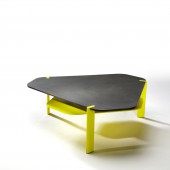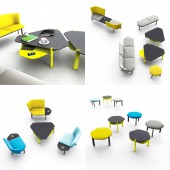Transition Center Table Modular Table System by Marc Scimé |
Home > Winners > #44616 |
 |
|
||||
| DESIGN DETAILS | |||||
| DESIGN NAME: Transition Center Table PRIMARY FUNCTION: Modular Table System INSPIRATION: Today old boundaries are blurring. Fewer professionals have their own assigned office space and how we work is changing, too. Work can literally happen anywhere, anytime. Leisure and activity, antonyms by classic definition, have become less mutually exclusive. Modern interiors are commonly open environments spatially delineated by furniture. Biophilic desires correlate with more types of architectural environments that seamlessly integrate the outdoors. UNIQUE PROPERTIES / PROJECT DESCRIPTION: The Transition center table is the core of Bend and Transition, a complementary seating and table ecosystem designed to delineate space in open environments, including residential, hospitality and contract common gathering areas. Transition offers flexibility to match lifestyles anywhere, anytime, indoors, outdoors and somewhere in between. When we're seated at a table, often we have multiple objects at hand—e.g. a cup of coffee, a tablet computer, and a book. The lower tiered tray of the Transition center table slides out, providing another option for placing things out of the way. OPERATION / FLOW / INTERACTION: The Transition center table is the core of Bend and Transition, a complementary seating and table ecosystem designed to delineate open space, including residential, hospitality and contract environments. Transition offers flexibility to match lifestyles anywhere, anytime, indoors, outdoors and somewhere in between. When we're seated at a table, often we have multiple objects at hand—a cup of coffee, a tablet computer, and a book. The lower tiered tray of the Transition center table slides out, providing another option for placing things out of the way. PROJECT DURATION AND LOCATION: The project started September 2014 in Pasadena, California, USA and finished in April 2015. Bend was exhibited at Art Center College of Design in Pasadena as part of the spring term graduate show. FITS BEST INTO CATEGORY: Furniture Design |
PRODUCTION / REALIZATION TECHNOLOGY: Prototyping of Transition utilized 3D CAD and 3D printing along with industrial equipment and methods. The aluminum structural components were CNC milled. The lower aluminum pull-out tray was water-jet cut and formed. Transition's top is made of Richlite, a durable and sustainable composite made of recycled paper-based fiber and water-based phenolic resin that is scratch, stain and heat resistant and is extremely rigid. For industrial production, Transition's aluminum components would be stamped or extruded then treated and powder-coated outdoor use. SPECIFICATIONS / TECHNICAL PROPERTIES: Transition center table: Width 1070 mm x Depth 1170 mm x Height 380 mm TAGS: Transition, table, coffee table, cocktail table, center table, occassional table, outdoor furniture, aluminum furniture RESEARCH ABSTRACT: The design of Transition culminated from my master's thesis titled Bend & Transition. The thesis writing and pre-design process entailed extensive research, citing nearly 100 sources, delving into aspects of modern history, evolving workplace and lifestyle trends and attitudes pertaining to the most basic aspects of modern living, and how these changes are reflected in new architecture and furniture design. CHALLENGE: Eight months of research, writing, design and prototyping to realize and exhibit Transition (and Bend) was a complete challenge. Designing, engineering and prototyping two types of furniture commenced through the final 18 weeks of project while research and writing were ongoing in parallel. This included research into production methods, material sourcing, and project managing the prototype building itself. At the same time, the collaborative and individual task of designing, promoting and building a graduation exhibition proceeded. A consummate level of project management was as a constant requirement to meet the final deadline with a publishable thesis, near-production-read ADDED DATE: 2016-01-26 19:16:32 TEAM MEMBERS (1) : IMAGE CREDITS: All photographic images by Charles Imstepf and Marc Scimé. Renderings and image post-processing by Studio for Design. PATENTS/COPYRIGHTS: © Marc Scimé | Studio for Design 2015 |
||||
| Visit the following page to learn more: http://marcscime.com/home | |||||
| AWARD DETAILS | |
 |
Transition Center Table Modular Table System by Marc Scimé is Winner in Furniture Design Category, 2015 - 2016.· Read the interview with designer Marc Scimé for design Transition Center Table here.· Press Members: Login or Register to request an exclusive interview with Marc Scimé. · Click here to register inorder to view the profile and other works by Marc Scimé. |
| SOCIAL |
| + Add to Likes / Favorites | Send to My Email | Comment | Testimonials | View Press-Release | Press Kit |
Did you like Marc Scimé's Furniture Design?
You will most likely enjoy other award winning furniture design as well.
Click here to view more Award Winning Furniture Design.








